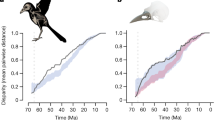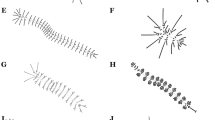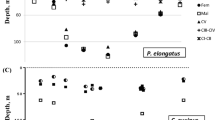Abstract
TWO problems in evolution are of continuing interest to biologists. These problems arise in connexion with the development of the special peculiarities which allow closely related species to exist side by side. If the process of evolution is regarded as a struggle for energy, a logical explanation may be found on the basis of the energetics of different species. The fact that the size of an animal is related in some way to its energetics makes it possible to test this supposition.
This is a preview of subscription content, access via your institution
Access options
Subscribe to this journal
Receive 51 print issues and online access
$199.00 per year
only $3.90 per issue
Buy this article
- Purchase on Springer Link
- Instant access to full article PDF
Prices may be subject to local taxes which are calculated during checkout
Similar content being viewed by others
References
Djuldin, A. A., and Mezhzherin, V. A., in Bion. Mat. Mod., 1, 109 (1969).
Mezhzherin, V. A., and Djuldin, A. A., Nature (in the press).
Mezhzherin, V. A., in Proc. IPB Meeting (edit. by Petrusewicz, K., and Ryszkowski, L.) (in the press).
Huxley, J. S., Evolution, the Modern Synthesis (Allen and Unwin, London, 1942).
Lack, D., Darwin's Finches (Cambridge University Press, Cambridge, 1947).
Mayr, E., Animal Species and Evolution (Harvard University Press, 1963).
Author information
Authors and Affiliations
Rights and permissions
About this article
Cite this article
MEZHZHERIN, V. Energetical Structure of Zoological Systems. Nature 231, 461–462 (1971). https://doi.org/10.1038/231461a0
Received:
Issue Date:
DOI: https://doi.org/10.1038/231461a0
This article is cited by
-
Chemische und biologische Aspekte der Fixierung und Reduktion molekularen Stickstoffs
Naturwissenschaften (1975)
Comments
By submitting a comment you agree to abide by our Terms and Community Guidelines. If you find something abusive or that does not comply with our terms or guidelines please flag it as inappropriate.



